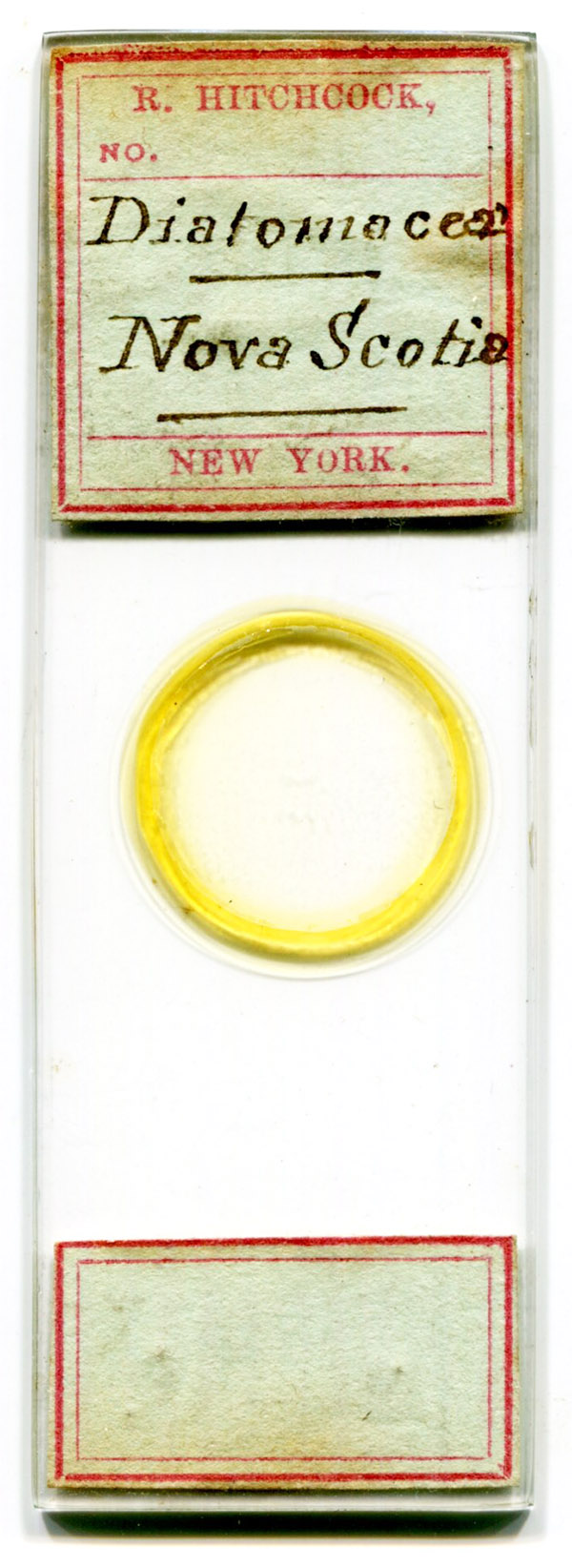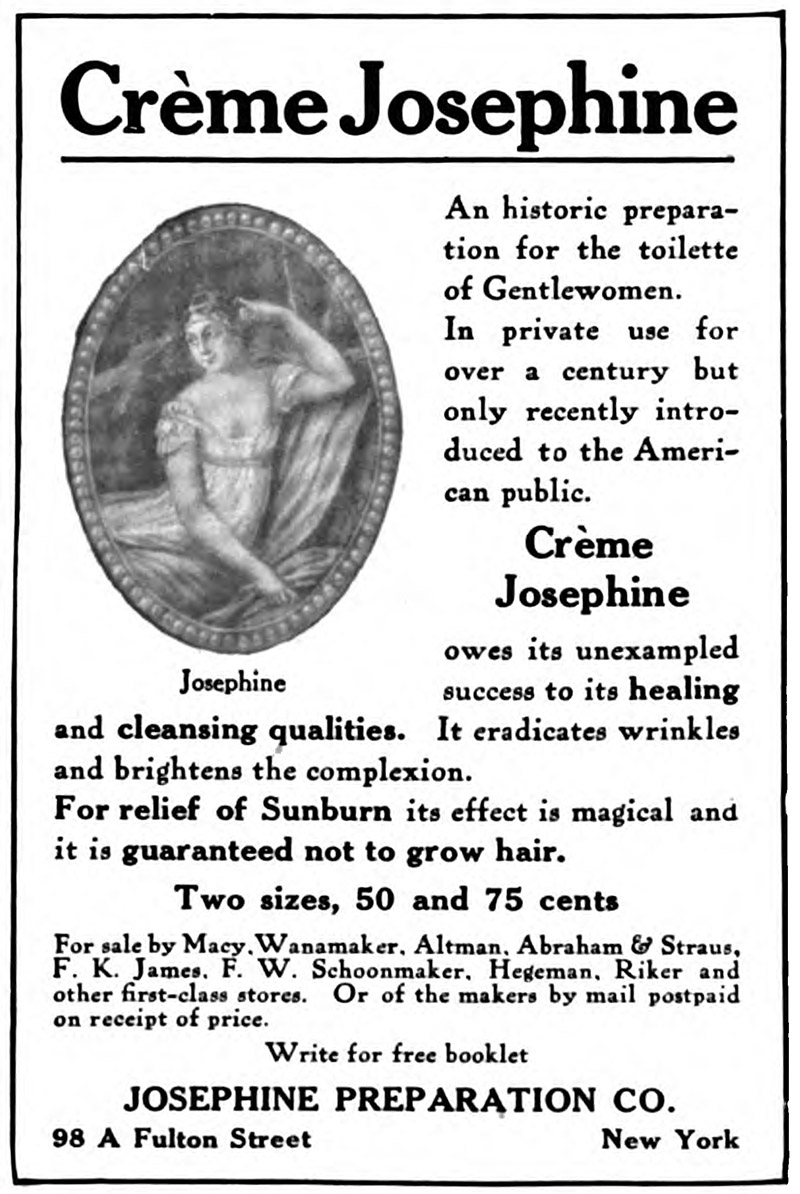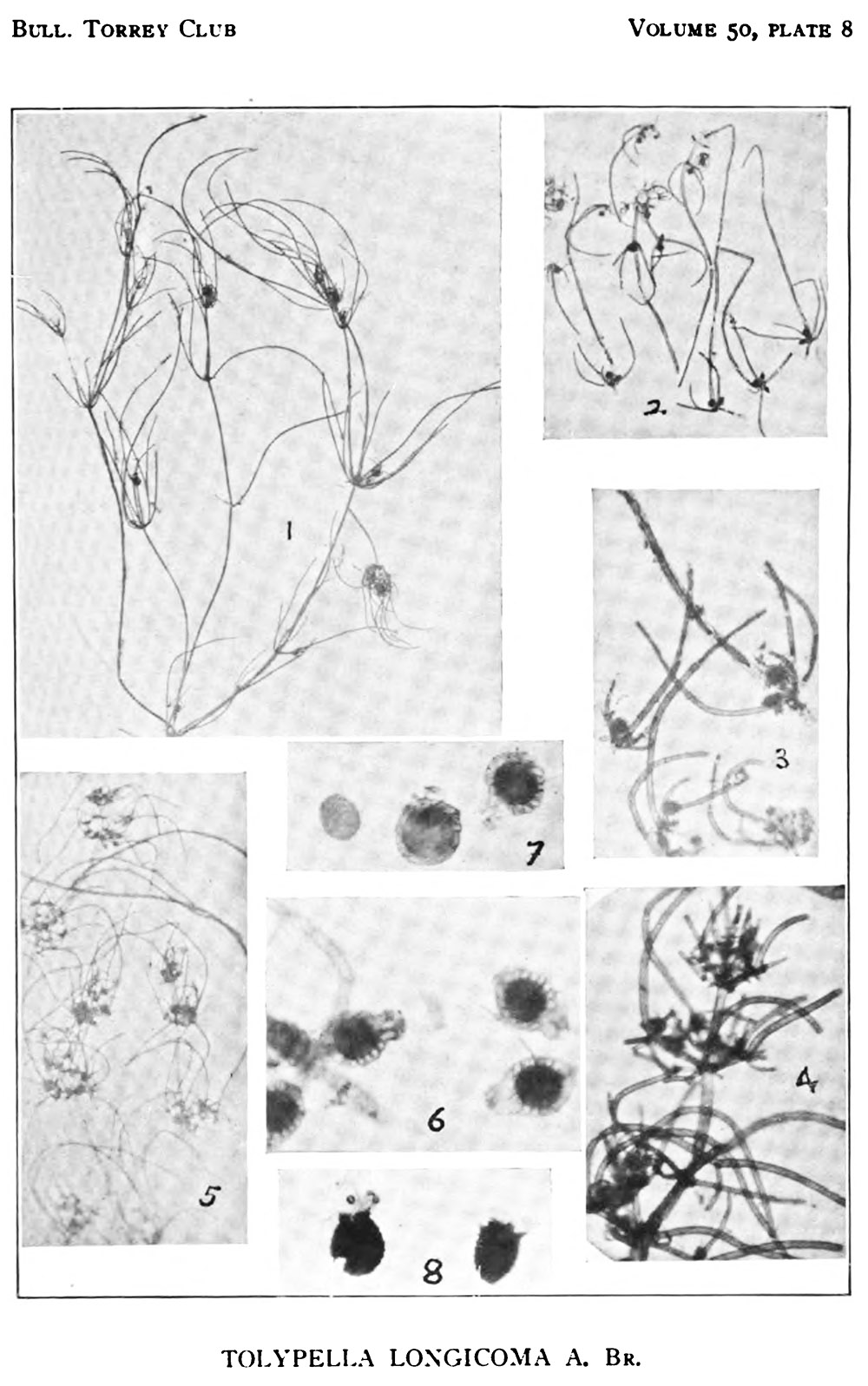Romyn Hitchcock, 1851-1923
by Brian Stevenson
last updated August, 2020
Romyn Hitchcock performed several important roles in the development of amateur microscopy in the United States. In 1878, he began publishing the American Quarterly Microscopical Journal, which became the American Monthly Microscopical Journal in 1880 and continued publication until 1902. He was a founding member of both the American Society of Microscopists and New York Microscopical Society. He became a Fellow of both the Royal Microscopical Society and the American Association for the Advancement of Science, and a Member of the American Chemical Society and the New York Academy of Sciences.
Hitchcock produced also microscope slides, for his own use and for exchange with fellow microscopists (Figure 1). Records indicate that he was particularly interested in diatoms, although he was proficient at mounting a wide range of specimen types.

Figure 1.
Circa 1880 microscope slide by Romyn Hitchcock, a strew of diatoms from Nova Scotia, Canada. The label bears the printed address of New York, where Hitchcock lived from 1877 until 1883, which also corresponds to the time when he was most active in microscopy.

Figure 2.
Cover pages of the first issues of Romyn Hitchcock’s “American Quarterly Microscopical Journal” (1878) and “American Monthly Microscopical Journal” (1880). At those times, Hitchcock operated a publishing and book distribution business in New York City. The partner in “Hitchcock & Wall” publishing was probably John L. Wall, who was also a founder of the New York Microscopical Society. The “American Monthly Microscopical Journal” was published from 51 & 53 Maiden Lane, New York, which was also the address of Hitchcock’s literature distribution business (Figure 3).

Figure 3.
1880 advertisements for Romyn Hitchcock’s scientific book publishing and distribution business, from an issue of the “American Monthly Microscopical Journal”.
Romyn Hitchcock’s father, Alonzo, was a mill wright and mechanical engineer. Early in his career, he and his wife, Hannah, travelled and built sawmills and flourmills throughout the US. While on a job in St. Louis, Missouri, Hannah gave birth to their first child, Romyn, on December 1, 1851. Another child was born in 1857, but Hannah died afterward. Alonzo moved his two sons to New York City, where he worked in the manufacture of heavy mining machinery.
Alonzo must have had a good job, since Romyn was able to attend college at Cornell University and the Columbia School of Mines. He graduated in 1872. Romyn then took a position as Assistant Professor of chemistry at Lehigh University, in Bethlehem, Pennsylvania. He also joined the editorial staff of American Chemist.
In 1875, he married Emma Louise Bingham. They did not have any surviving children.
From 1876 to 1877, Romyn served as Professor of chemistry and toxicology at the Chicago Homeopathic Medical College.
A major career change occurred in 1877, when Romyn moved back to New York City and established a book selling and publishing business. The 1880 census records that he and Emma lived with his father. Alonzo died in 1884, and Romyn and Emma left New York around the same time, so it may be that they moved to New York in order to care for the aging Alonzo.
Romyn had a strong interest in microscopy by the time he moved to New York, perhaps fostered by classes that he took in college. He was one of four men who began organizing the New York Microscopical Society in late 1877:
“On the 12th of November, 1877, a letter was written calling a meeting at the residence of Mr. W.C. Hubbard, No. 109 West 13th street, on the evening of the 14th, for the purpose of forming a microscopical society in the city of New York, provided sufficient interest was manifested in the project. This letter was signed by Messrs. J.D. Hyatt, J.L. Wall, W.C. Hubbard, and R. Hitchcock. A copy of the letter was sent to twenty gentlemen, nearly all of whom were strangers to the writers, and promptly at the appointed time twelve of them responded to the call. The names of these are here given: Messrs. T.F. Hance, Chas. H. Haswell, R. Hitchcock, J.A. Hoyt, W.C. Hubbard, Rev. W. Huckel, J.D. Hyatt, A.A. Julien, John Phin, A.J. Swan, J.L. Wall, G.I. Whitehead.
The first few meetings were entirely occupied with the business of organization. On December 11, 1877, the first election of officers was held, which resulted as follows: Officers for 1878. President, J.D. Hyatt; Vice President, G.I. Whitehead; Corresponding Secretary, A.J. Swan; Recording Secretary, R. Hitchcock; Treasurer, W.C. Hubbard; Librarian, D. Bryce Scott (acting curator); Auditors, J.L. Wall, C.H. Haswell, J. Michels”.
Within the first year, Hitchcock had made dozens of contributions to the Society’s slide cabinet, consisting primarily of strews from diatomaceous deposits and chemical crystals for polariscope examination.
In August, 1878, Hitchcock attended the first National Microscopical Congress in Indianapolis, Indiana. The organizers had invited leading microscopists from throughout the country, and many scientists and instrument manufacturers attended. This meeting led to establishment of the American Society of Microscopists, with Hitchcock and others as charter members.
Also in 1878, Hitchcock began production of a new magazine, American Quarterly Microscopical Journal. He served as editor, and it was published by “Hitchcock and Wall”, presumably a partnership with fellow New York Microscopical Society member John L. Wall (see above). Two years later, in 1880, production of this successful magazine increased to 12 issues per year, as The American Monthly Microscopical Journal.
Hitchcock was elected President of the New York Microscopical Society in 1880. Around that time, he was also elected as a Fellow of the Royal Microscopical Society.
An exchange offer in an 1882 issue of The American Monthly Microscopical Journal provides an indication of Hitchcock’s slide-making specialties, and is consistent with known donations to the New York Microscopical Society and the slide shown in Figure 1: “Mounted crystals for the polariscope, diatoms (a fine collection), fresh-water algae foraminifera, in exchange for other well-mounted objects. Send specimens and full value will be returned. R. Hitchcock, 53 Maiden Lane, New York”. The Maiden Lane address was his publishing/book selling business - the Hitchcocks lived at 28 Beekman Place.
In 1883, Romyn took a curator position at the U.S. National Museum (i.e., the Smithsonian Institute) in Washington, D.C., working in the textile division.
Ownership of The American Monthly Microscopical Journal passed to Charles W. Smiley in 1887. Henry L. Osborn took over as Editor. The magazine continued publication until 1902.
That seems to have largely ended Romyn Hitchcock’s involvement with amateur microscopy. He did, however, use the microscope for his professional work. For example, he published “Preparation of microscopical mounts of vegetable textile fibers” in an 1886 Report of the Smithsonian Institution.
The Japanese government invited Romyn to teach English at a government school in Osaka in 1886. He and his wife, Emma, lived in Japan for the next two years. Both Romyn and Emma wrote of their experiences abroad. During that time, he directed the photographic work of the 1887 United States expedition to observe that year’s solar eclipse in Japan. The Hitchcocks arrived back in New York on January 14, 1889, on a steamer from Bremen, Germany.
A short time later, they went to China to help that country’s government prepare for the 1893 World's Columbian Exposition in Chicago.
Hitchcock moved back to New York City by 1900. That year’s census listed him as a “Chemistry Professor”, living on Broadway. A later issue of Who’s Who in America stated that he was a “consulting chemist and technologist since 1899”.
By 1908, he was President of the Josephine Creme Company, a producer of skin-care products (Figure 4). In 1909, he presented lectures on “Corporate organization and capitalization of industries” at Cornell University. In 1910, Hitchcock was awarded a patent for “keyboard apparatus for punching telegraphic transmitting-tapes”.
Some time afterward, Hitchcock moved to Ithaca, New York to teach at Cornell and perform botanical research. He published his last paper just before his death, on “Tolypella longicoma in Cayuga Lake, New York” (Figure 5).
The December 13, 1923 issue of Cornell Alumni News included, “Romyn Hitchcock, '72, well known as a research botanist, chemist, and professor of English, and for many years a resident of Ithaca and a lecturer at Cornell, died on November 30 at Baltimore , Md. He was born in St. Louis, Mo., on December 1, 1851. After gaining his early education, he was attracted by the prominence given the sciences and came to Cornell, where he passed the first examinations in Military Hall and entered the University at its opening. During his freshman year he became a member of Delta Upsilon and also won first prize for rapid work in chemistry. At the end of his junior year he left Cornell and in 1871-2 took a special course in the Columbia School of Mines. In 1872-4 he was assistant professor of chemistry at Lehigh and in 1876-7 was professor of chemistry and toxicology at the Chicago Homeopathic Medical College. In 1878 he became one of the publishers and editor of The American Microscopical Journal and for many years after was a writer for that paper as well as other publications; his articles received wide attention. In 1883 he was appointed curator of the National Museum at Washington, a place which he held until 1886, when he went to Japan as professor of English in Koto Chu Gakko, a Japanese Government school at Osaka, where he remained for two years. Later he served as commissioner to China in aiding that country to be represented at the World's Columbian Exposition. In late years, Mr. Hitchcock had made special studies in botany and was a fellow of the American Association for the Advancement of Science and of the Royal Microscopical Society of England, and a member of the American Chemical Society, the New York Academy of Sciences , and the New York Microscopical Society. He was married on April 24, 1875 to Miss Emma Louise Bingham of Ithaca, who survives him. (the Romyn Hitchcock papers and his lantern slides of the Orient are archived in the Cornell University Library, Ithaca NY)”.
Hitchcock was further honored by an obituary in Nature: “We have received information of the death last November, at Baltimore, of Prof. Romyn Hitchcock, who did much to further the study of microscopy. Born in 1851, he studied science at the Cornell University and Columbia School of Mines, and his subsequent career was one of varied activities. He was assistant professor of chemistry, Lehigh University, 1872-74; professor of chemistry and toxicology, Chicago Homeopathic Medical College, 1876-77; judge of awards for the United States on several of the juries at the Fisheries Exhibition, London, 1883; curator in the National Museum, Washington, 1883-86; and professor of English, Government School, Osaka, 1886-88. While at the last named he was in charge of the photographic work of the United States eclipse expedition, 1887. After his return from Japan, he spent a year in China as United States Commissioner in connexion with the World's Columbian Exhibition. Prof. Hitchcock's literary activities covered a wide range, and dealt with automatic telegraphy, mining, photography, and Japanese archeology. In later years he published papers on botanical subjects in the Bulletin of the Torrey Club, and at the time of his death he was investigating the staining reactions of the living nucleus of the vegetable cell”.

Figure 4.
A 1910 advertisement from the Josephine Crème Corporation, of which Romyn Hitchcock was President and Director.

Figure 5.
Photographs by Romyn Hitchcock from his last publication, on "Tolypella longicoma in Cayuga Lake, New York", 1923, “Bulletin of the Torrey Botanical Club”.
Resources
Annual Report of the USA Patent Office for 1910 (1911) page 236
The American Journal of Microscopy and Popular Science (1880) Report of the New York Microscopical Society, “At the Annual Election, which took place on January 13, 1880, the following were elected as officers for the ensuing year: Romyn Hitchcock, President; John L. Wall, Vice President; W.H. Mead, Rec. Secretary; B. Braman, Cor. Secretary; W.C. Hubbard, Treasurer; F.M. Deems, Librarian and Curator; C.S. Shultz, James Warnock, David Benson, Auditors”, page 51
American Monthly Microscopical Journal (1880) Advertisements from Romyn Hitchcock’s publishing company, Vol. 1
American Monthly Microscopical Journal (1882) Exchange offer from Romyn Hitchcock, Vol. 3, page 200
American Monthly Microscopical Journal (1887) Vol. 8
Annual Report of the Board of Regents of the Smithsonian Institution (1884) “Mr. Hitchcock, the curator of the textile collection, has been principally occupied in exposition work, in connection with which he undertook the preparation of a collection of textile fibers and fabrics. Portions of this collection were exhibited both at Louisville and Cincinnati”, page 55
Cornell Alumni News (1923) Obituary of Romyn Hitchcock, Vol. 26
Hitchcock, Romyn (1878) Micrometry, American Quarterly Microscopical Journal, containing the Transactions of the New York Microscopical Society, Vol. 1, pages 9-11
Hitchcock, Romyn (1878) Oblique illumination and means of obtaining it, American Quarterly Microscopical Journal, containing the Transactions of the New York Microscopical Society, Vol. 1, pages 11-15
Hitchcock, Romyn (1878) Angular aperture defined, The American Quarterly Microscopical Journal, containing the Transactions of the New York Microscopical Society, Vol. 1, pages 50-55
Hitchcock, Romyn (1882) Remarks on the illumination of insect preparations mounted without pressure, American Monthly Microscopical Journal, Vol. 3, page 219
Hitchcock, Romyn (1885) Studies of Amebae, American Monthly Microscopical Journal, Vol. 6, pages 135-136
Hitchcock, Romyn (1885) Manipulations of the microscope, American Monthly Microscopical Journal, Vol. 6, page 140
Hitchcock, Romyn (1885) Optical arrangements for photo-micrography and remarks on magnification, American Monthly Microscopical Journal, Vol. 6, pages 168-170
Hitchcock, Romyn (1885) Testing objectives, American Monthly Microscopical Journal, Vol. 6, pages 177-178
Hitchcock, Romyn (1885) Fixing arranged diatoms and sections, American Monthly Microscopical Journal, Vol. 6, page 233
Hitchcock, Romyn (1885) The striae of diatoms on the Möller Probe-Platte, American Monthly Microscopical Journal, Vol. 6, page 234
Hitchcock, Romyn (1885) A new mounting medium of high refractive index, American Monthly Microscopical Journal, Vol. 7, pages 3-4
Hitchcock, Romyn (1885) Note on the Spencer-Harrison controversy, American Monthly Microscopical Journal, Vol. 7, pages 18-19
Hitchcock, Romyn (1886) Mounting media, American Monthly Microscopical Journal, Vol. 7, page 74
Hitchcock, Romyn (1886) Investigation of microbes, American Monthly Microscopical Journal, Vol. 7, pages 74-76
Hitchcock, Romyn (1886) Preparation of microscopical mounts of vegetable textile fibers, Report of the Smithsonian Institution, pages 657-658
Hitchcock, Romyn (1886) List of specimens of textiles and fabrics in the reference series of the Section of Textile Industries in the U. S. National Museum, Report of the Smithsonian Institution, pages 649-655
Hitchcock, Romyn (1888) The preparation of Japanese lacquer and the manufacture of Wakasa lacquer ware, Proceedings of the United States National Museum, Vol. 9, pages 473-479
Hitchcock, Romyn (1888) Notes on eclipse photography, Anthony's Photographic Bulletin, Vol. 10, pages 680-684
Hitchcock, Romyn (1889) The action of light on silver chloride, American Chemical Journal, Vol. 11, pages 474-480
Hitchcock, Romyn (1890) A method of mounting photographic prints without cockling, Anthony's Photographic Bulletin, Vol. 21, pages 74-76
Hitchcock, Romyn (1923) Tolypella longicoma in Cayuga Lake, New York, Bulletin of the Torrey Botanical Club, pages 173-176
Journal of the Royal Microscopical Society (1889) List of Fellows
Nature (1878) “Commencing, as this new journal does, on the lines of our own ‘Quarterly Journal of Microscopical Science’, and somewhat under the like auspices, we trust it may have the same worthy career, and be equally well thought of. The first number is beautifully printed on excellent paper, and contains some eighty-two pages belonging to the journal proper, while the Transactions of the New York Microscopical Society extend to some sixteen pages more. ‘The American Quarterly Microscopical Journal, containing the Transactions of the New York Microscopical Society’. Edited by Romyn Hitchcock. Vol. I., No. 1. October. (New York: Hitchcock and Hall, 1878.)”, page 145
Nature (1924) Obituary of Romyn Hitchcock, Vol. 113, pages 615-616
New York Directory (1880) “Hitchcock Romyn, editor, 53 Maiden la. h 28 Beekman pl.”, page 710
New York Directory (1880) “Wall John L., baker, 338 Sixth av., h 64 W. 21st”, page 1558
Official Gazette of the United States Patent Office (1904) “10,938-Title: ‘Créme Josephine’ (For Toilet Preparation.) The Josephine Créme Company, New York, N. Y., Filed March 14, 1904”, page 1883
Transactions of the New York Microscopical Society (1878) History of the Society up to the present date, Vol. 1, pages 3-8
The Trow (formerly Wilson's) Copartnership and Corporation Directory of Boroughs of Manhattan and the Bronx, City of New York (1908) “Josephine Creme Co. (N. T.) (Romyn Hitchcock, Pres.; A. Stanley Graff. Sec. Capital, $15,000. Directors: Romyn Hitchcock, A. Stanley Graff, George R. Macey) 96 Fulton R. 6”, page 418
US census and other records, accessed through ancestry.com
Who's Who in America (1910) Hitchcock, Romyn, Vol. 6, pages 917-918




